Introduction, Specifications, and Pricing
There is a formula to building a successful NAS for system administrators. It's like a straight line from two points. The more a company deviates from the formula to improve the system; the line begins to blur from the ripple. We often see this happen from companies trying to incorporate consumer, business, and enterprise functions in the same system by simply tossing everything in and hoping the user finds something useful. The QSAN XCubeNAS is not a bucket of paint thrown at the user. This is a system with a targeted purpose and focused features designed to keep your business' storage secure.

Most of QSAN's product line targets large business storage needs with the flagship system incorporating up to 24 hard disk drives and Intel Xeon processors. The company has recently turned the dial down on some XCubeNAS series products to reach a wider market.
The XCubeNAS XN8008T we're testing today incorporates many of the features of the enterprise-scale products but puts them in an easier to manage small business-friendly form factor. This system uses a pedestal design as opposed to the beastly rackmount system.
The smaller size doesn't mean businesses have to compromise on features. The base XN8008T system brings ample processing power and system memory to power a large office right out of the box. Optional memory and connectivity options increase the number of simultaneous users the system can handle (10Gb and 40Gb Ethernet) and can even change the functionality (Thunderbolt 3 DAS).
The system's main purpose is to provide a reliable storage environment that protects against data corruption. The product uses QSAN Storage Management 3.0 (QSM 3.0) on a custom Linux kernel to run a 128-bit ZFS file system. QSM doesn't have many of the flashy features you would find on a QNAP, Thecus, or Asustor system but we're fine without the distractions on a true business-focused system. System administrators get core features often used today in production environments and enough icing to give a fulfilling sweet taste.
Specifications
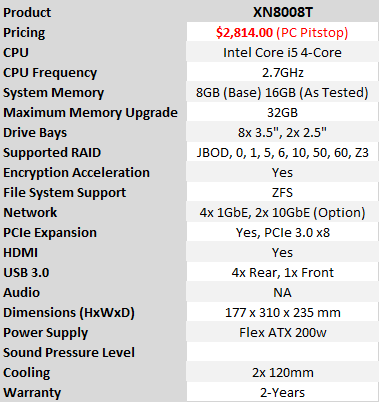
The QSAN XN8008T is the company's flagship pedestal NAS built for business use including applications that can run directly on the system. The XN8008T features a powerful 7th-generation Intel Core i5 processor running at 2.7GHz across four cores with a Turbo speed of 3.3GHz. Looking online, we found the system shipping with 8GB of system memory but ours arrived with 16GB packed into two DDR4 SODIMMs. The NAS supports up to 32GB of system memory and uses commodity non-registered, non-ECC DDR4 2400-class.
QSAN builds similar models with less drive bays, but this SN8008T features 8 3.5" and a single 2.5" used to build a read or write cache SSD that sits in front of the disk array. The system uses a ZFS files system on the disks, but users can virtually load drives with an assortment of other file systems.
Connectivity comes from five USB 3.0 ports with one on the front paired with a copy function button. The system does feature an HDMI port, but at this time, we didn't find any applications on the system to takes advantage of multi-media functions. The system runs Linux so it would be possible to implement software like KODI to take full advantage of the single HDMI port.
Network connectivity comes from four gigabit-Ethernet ports on the back of the system. The XN8008T features a single PCIe 3.0 x8 slot inside the system. Resellers can sell and configure the system with either a dual SFP+ 10GbE, or a Thunderbolt 3 card to increase network bandwidth or add direct-attached storage features to the system.
Cooling comes in the form of two large fans on the back of the system. In our testing, we never heard the system ramp up fan speeds to audible levels in our testing environment. At idle the system reports fan speed around 600 RPMs. Disk temperatures at idle using Seagate IronWolf Pro 12TB models reported between 39C and 47C with the highest measure coming from disk 1.
Software Features
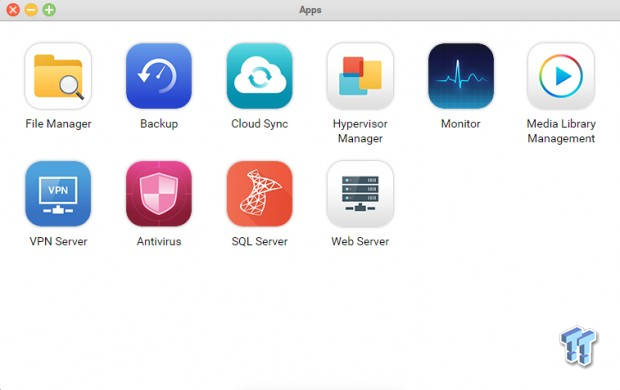
The system ships with some applications but the included list is scant compared to industry veterans QNAP, Thecus, and Asustor.
Users enjoy a full array of backup options that include snapshots, remote and rsync options. Users can also target Google, Dropbox, Amazon, and Microsoft cloud backup accounts with synchronizing from local storage to the cloud or the cloud service replicating to the NAS.
With a SSD installed in the system as a read cache, the XN8008T supports deduplication of data. We suspect there is a performance penalty from enabling the option but plan further tests later to examine the full impact.
Additional features include:
- Site Recovery Manager (SRM) certified
- vStorage APIs for Array Integration (VAAI) certified
- Windows Offloaded Data Transfer (ODX)
- Microsoft Hyper-V certified
- Citrix Ready
- Flash: 8GB USB DOM
- Hard Drive Interface: SATA 6Gb/s (backward compatible with SATA 3Gb/s)
- Expansion Slot: PCIe Gen3x8 for 10 GbE/ 40 GbE / Thunderbolt 3.0 / SAS adapter cards.
Pricing and Warranty
QSAN does not have the same robust distribution network as many of the established brands with consumer-focused product lines. In the US we found QSAN systems on Amazon, but this the model we plan to test today. PC Pitstop does carry the XN8008T with a base price of just over $2,800.
PC Pitstop also carries the 10GbE with dual SFP+ card for an additional $359.99. The Thunderbolt 3 adapter card also carries a $359.99 price. The site also shows a third option for the onboard PCie 3.0 x8 slot. Users can opt to load a dual-port SAS 12Gb JBOD expansion card, but it's a costly option at $509.99. We were not able to find an RJ45 10-gigabit Ethernet option for this series at this time. The XCubeNAS manual also lists a 40GbE card, but we didn't find one available at the time of writing.
QSAN backs the XCubeNAS series with a standard 2-year warranty.
A Closer Look

The system uses a sleek design that is both stylish and functional. Hidden status lights on the front keep users informed to disk, network, and connection activities. The single USB 3.0 port on the front of the system allows for easy device when users enable the one-touch-copy function.


The drive sleds are tool-less with easy to manage rails that lock into place for the 3.5" and form-fitting sides for the 2.5". The system does use a small tool to lock the front drive bays as well as the cover for the 2.5" drive location.

The same removable panel also exposes the DDR4 2400 SO-DIMM modules. In the image, you can see a small oval area hidden on the vertical black strip. This is where you press the tool into the NAS to unlock the hidden door. The same tool locks the drive sleds in place. An area on the back of the NAS holds the tool with a magnet if you want to keep the NAS and the unlocking system in close proximity.

The system uses a simple IO layout with the four USB 3.0 and four gigabit Ethernet ports clustered over a reset button and a Kensington Lock port used to secure the NAS to a solid structure.
The two massive fans keep the drives and other internal components cool. A series of screws on the upper portion of the system secure the top panel that you remove to install an add-in card. The card must use the flat style IO plate. Our sample system arrived with a dual port 10GbE adapter sporting SFP+ connectors.


The system does have an HDMI output for display connectivity, but we didn't have any software to run, like KODI, to use the port for advanced multimedia functions. Given this system's strong CPU performance and low noise, it would make an excellent system for movie enthusiasts if QSAN were to release applications for that purpose.

The system uses six vibration-dampening pads on the bottom to isolate vibrations from passing through to the desktop or other surface.
CIFS Performance Testing
Testing Notes
We used an entirely new test procedure on the QSAN XN8008T NAS. The results are from an outdated version that we've already replaced a number of times over while sorting the bugs out. Due to the limited lifespan of this exact set, there are only two systems in the charts with three results.
The first result is the QSAN XN8008T with eight-12TB Seagate IronWolf Pro HDDs (our standard HDD for testing NAS) running RAID 6 (our standard test for systems over six drives). The second set of results adds a 480GB SanDisk Extreme Pro SSD to fill the flash-based cache role in the system. The third result is for our Thecus N8880U-10G loaded with the same 12TB Seagate IronWolf Pro HDDs in RAID 6.
The QSAN GUI allows us to set the cache SSD to read or write only. The software doesn't allow us to cache both. You don't have a choice on what type of data to cache, either. Some systems allow users to cut the cache off at a block size. For instance, caching only small block size data normally associated with random reads and writes. The system appears to block the sequential data from the SSD cache tier automatically.
We're using a modified QCT server with dual Intel E5 2670 8-core CPUs and an Intel 10-gigabit NIC to stress the systems under load. Both systems connect to a Supermicro SSE-X3348TR enterprise switch that we reviewed in 2014.
Sequential Read Performance
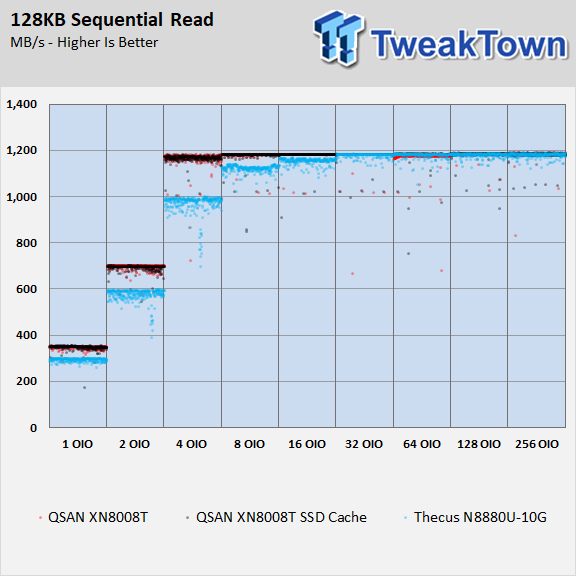
The two systems reach the peak bandwidth of just over 1,200 MB/s. The QSAN system reaches the goal by queue depth (QD) 4. Our Thecus system used as a bassline is still 200 MB/s shy at QD4 and even falls short at QD8.
Sequential Write Performance



The QSAN system manages to outperform the baseline Thecus system in sequential data writes using the 128KB block size. The Thecus was never able to reach the full bandwidth of the interface before latency began to reduce throughput performance.
Each dot on the chart represents a recorded IO. The QSAN system keeps the performance in a much tighter grouping. There are simply less latency spikes.
Sequential Mixed Workloads

This chart shows us just how powerful the XN8008T NAS really is. The network connect is bidirectional 10-gigabit so we sequential workloads with data going on each direction we see combined throughput that is higher than 1,200 MB/s. Many of the NAS we've tested actually lose performance in the mixed workloads and increased "scatter" of the results due to higher latency.
Random Read Performance


The random read test shows us the SSD coming into play when enabled in the software. The drive helps to increase consistency and increase random read performance.
The second chart in this group shows random read distribution, IOPS on the bottom and latency on the vertical axis. The SSD allows the QSAN system to perform with increased efficiency before the higher workload send the system into the curve from increased latency.
Random Write Performance



The Thecus N8880U-10G uses some of the system memory to cache user data, and that shows on the 4KB steady-state chart. There are several IOs with very high peaks, but there are just as many measurements without a single IO taking place in the 1-second recording interval.
The second chart shows the QSAN with the SSD installed keeping a much tighter grip on the performance consistency even in the random write test. In the settings, we configured the drive for read caching but it appears to use some of the drive for small block size random writes as well.
Random Mixed Workloads

The random mixed workload test shows how the cache helps to keep the performance consistent especially with 100% random writes (on the far right of the chart).
Server Workloads
Database




In this section, we move our attention over to server workloads starting with the database. In the workloads, we also see the effects of flash-based cache in the form of higher performance, lower latency, and often increased consistency.
The biggest factor though is still the processing power of the NAS. In these tests, we loaded the same number of Seagate IronWolf Pro 12TB HDDs into both systems. The QSAN uses the Intel Core i5 quad-cores, and the Thecus uses an Intel Core i3 with dual cores.
OLTP


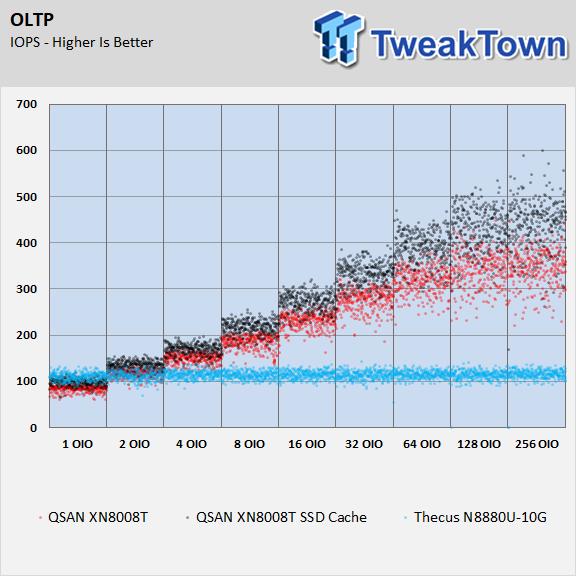

The OLTP test is very similar to the database test we just looked at. The statements from the last section carry over to this workload.




The email workload more data sizes than the database and online transaction processing workloads. This test requires more hard disk drive interaction with less of the data falling into a cache on the system. Again, we see strong performance scaling with the QSAN than the processor-limited Thecus. The QSAN system armed with a strong consumer MLC SSD delivers a 4x increase in the amount of IO data over the Thecus system.
Archival File Server




The archive test comes from Dell in the SIM-Real-World_Workload-2.1.0.icf file was last updated by J.Heinz on March of 2016. We made some changes to the length and queue depth of the test but stayed true to the file access and distribution.
Multiclient Office Workload

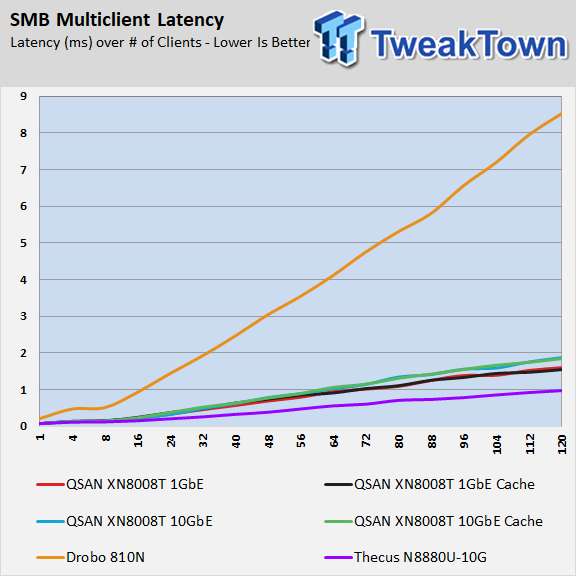
The Multiclient test uses an array of Xeon powered servers to work the NAS from multipole points. Each "client" is a Hyper-V instance with a dedicated CPU core, operating system, and gigabit Ethernet port. The software runs a series of Office software with the data on the NAS under test. The workload is the same for each client, but offset in each instance, so the NAS isn't reading the same file and then distributing the data to several machines in parallel from identical requests.
We had issues getting the SSD cache to "warm up" in this test for some unknown reason. This is a test we expected the XN8008T run circles around the two year old Thecus N8880U-10G. It's not that the XN8008T performed poorly. In the chart, we also included a Drobo 810N to show the performance of a prosumer system.
Final Thoughts
QSAN's business-focused XCubeNAS lineup scales to meet the needs of the modern office. The company features 2-bay, 4-bay, 6-bay and the 8-bay system we tested today. There are also similar models with lower processing power still available that cost significantly less but tailored to smaller offices that still require robust storage options with an eye on reliability.

We tested the flagship 8-bay pedestal model today and couldn't ask for anything more for it's designed purpose and target market. Consumers looking for more "fun" features like Plex should look elsewhere, but this isn't a problem for the XCubeNAS. Some administrators may find the temptation too great on other systems, but without the option, you don't have to worry about a rogue employee using company resources to play, or potentially puts your business in the middle of an expensive lawsuit. Additionally, without the extra consumer-focused features, the XCubeNAS stays more secure, and that benefit outweighs the desires of a few.
All of this performance does carry a steep price. The 8-bay system we tested today sells for just over $2,800 without the additional system memory or faster 10GbE connection option. The XN8008T is one of the more expensive pedestal systems we've tested in recent years, but it's also one of the fastest. The performance results show the system never reached a zero IO event for a one second period, unlike the N8880U-10G rackmount system we tested it against. This proves that a company can build a contestant network storage appliance outside of the traditional rackmount structure.
Given the price and the targeted user group, we would like to see a better locking mechanism for the drives to keep them secure. Most of these systems will hide under lock and key in a dedicated room, but the extra security would go a long way ease business owners.

 United
States: Find other tech and computer products like this
over at
United
States: Find other tech and computer products like this
over at  United
Kingdom: Find other tech and computer products like this
over at
United
Kingdom: Find other tech and computer products like this
over at  Australia:
Find other tech and computer products like this over at
Australia:
Find other tech and computer products like this over at  Canada:
Find other tech and computer products like this over at
Canada:
Find other tech and computer products like this over at  Deutschland:
Finde andere Technik- und Computerprodukte wie dieses auf
Deutschland:
Finde andere Technik- und Computerprodukte wie dieses auf